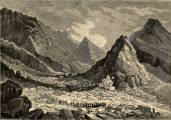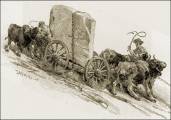


The Kentucky Stone and Building Industry, 1886
Excerpts from
Mineral Resources of the United States, Calendar Year 1886
David T. Day, Chief of Division of Mining Statistics and
Technology
Department of the Interior, United States Geological Survey
Government Printing Office, Washington, D. C., 1887.
Excerpts from the chapter on Structural Materials, by William C. Day.
"The year 1886 opened with encouraging prospects for the building industry generally throughout the country, but scarcely were active operations fairly under way when the widely-spread labor disturbances which have made the year memorable began, making themselves felt in a number of the largest cities, both in the east and west. As soon as the labor troubles were inaugurated, many building enterprises were abandoned, and many more were postponed until the differences between labor and capital should be smoothed over. The building operations which were carried on during the period of disturbance were in most cases attended by small margins of profit to all concerned, and in some instances by disaster to contractors and to those who supplied material. Business was dull for all branches of trade connected with the building industry; demand for material was low and irregular, and values fell off quite considerably.
"This period of general depression was, however, followed by one of the greatest activity, and while it is true that many building enterprises contemplated at the beginning of the year were abandoned and not taken up again in 1886, still the fact remains that at the close of the year the showing made by the principal cities of the country was a large increase in the amount of building done, as compared with 1885.
"The kind of buildings most extensively erected during this period of activity consisted of residences, the demand for which, in view of our rapidly increasing population, is naturally at all times imperative.
"Only a few cities show positive evidence to the effect that building operations for the entire year were curtailed owing to the influence of labor troubles, although, of course, the frequently-propounded question, "What would have been the amount and value of building done in 1886 had there been no serious interruption?" is one which no one can satisfactorily answer."
New York City, New York: "The study for strong and effective contrasts indulged in for some ten years past has resulted in the introduction of a considerable variety of stones, chiefly quarried in the South and West. Among these may be mentioned the oolitic limestone from Bedford, Indiana, as well as from Kentucky, Tennessee, and Georgia. Marble from Vermont and Georgia is used to a liberal extent."
"The building stones (in Atlanta, Georgia) most used are: granite taken from quarries 16 miles from the city; limestone from Indiana, Bowling Green, Kentucky, and Dickson, Alabama; brown sandstone from North Carolina, and marble from the vicinity of Marietta, Georgia."
"The building stone chiefly used (in Memphis, Tennessee) includes limestone from Dickson, Alabama, sandstone from Mount Sterling, Kentucky, granite from quarries near Little Rock, Arkansas."
"In this city (Little Rock, Arkansas) limestone from Dickson, Alabama, and oolitic limestone from Kentucky are used chiefly; granite from quarries near the city is also employed, but not to a great extent, owing to cost of cutting."
Louisville, Kentucky: "Among the various kinds of stone used in Louisville may be mentioned the following: Oolitic limestone from Bedford, Indiana, also from Salem and Bowling Green, Kentucky. Buena Vista, Ohio, Lake Superior, and Long Meadow sandstones are used to a limited degree. Brick with stone facings or with ornamental brick and tile trimmings is largely used in buildings of the better class. It cannot be said that there is a marked increase in the use of slate."
Commercial use of material within this site is strictly prohibited. It is not to be captured, reworked, and placed inside another web site ©. All rights reserved. Peggy B. and George (Pat) Perazzo.